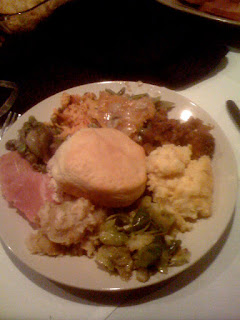Family Potluck Christmas with 2008 Kendall-Jackson Chardonnay: 4/5

Sorry about the delay on the conclusion of Battle Ham. Incase you missed the basis of the challenge, I will tell you again. Knowing full well that my mom was going to make a ham on our family Christmas on Sunday, I decided to make a ham on Christmas day, to compare the two in BATTLE HAM!
Although my mom was not as enthused as I was, when I told her, she said, “That’s a good Idea, I don’t really do anything special to my ham, I just pop it in the oven.” With victory on my taste buds, I waited while mom’s basic ham baked in the oven.
For holiday feasts, my family likes the idea of a pot luck. Usually the host will prepare the appropriate protein, and everyone else will bring appetizers, sides, or desserts. With the enormous amount of food, everyone is left to lunch on leftovers for the next week.
This Christmas was no different, although my mom took it upon herself to make scalloped potatoes, corn pudding, and rolls as well. My grandpa’s wife Pat brought green bean casserole, my grandma, coleslaw, my Aunt Molly, fruit and homemade fruit dip, and Michael and I, my Christmas bonus from the Cheesecake factory, a cheesecake. Since my brother Jeff and his wife Michelle had to drive all over god’s wintery earth this Christmas they were excused from cooking.
My mom is more of a beer vs. wine drinker, and when it comes to the extent of her wine knowledge, it goes about as far as the box of red in the refrigerator and a couple bottles around the house. We could of brought a bottle to bring, but by the time I thought of it, we were already in the car and on the way. So I crossed my fingers and hoped for the best.
Consisting of a a couple bottles of Barefoot, Yellow Tail, and a few others, the selection was looking scarce, until I stumbled upon a bottle of Kendall-Jackson Chardonnay. Now I know I said that ham is a red meat and should be paired with red wine, but if there were any white that would to stand up the fat in ham, it would be Chardonnay. With a description of an arrangement of fruit from apples to mangos, and an alcohol content of 13.5% apv, there was a chance that the Chard would fit the bill.

Initially I thought my mom got a spiral ham, but after inspecting it in the oven there was nothing spiral about it. In the past there have been syrupy glazes, and cloves, but this year I guess my mom wanted to keep it simple. So as the plain ham came out of the oven, I began to wonder, did I do to much to my ham?
Surveying the spread, my eyes began to inflate with my stomach. Since my family has never had a giant dinning room, we always do buffet style when it comes to big get together, usually complete with food that wraps around the entire kitchen. I like to stuff as much as I can on my plate, portioning out each item in a pie chart fashion.
As we corked the bottle of wine and everyone made their rounds, my mouth began to salivate, and my nerves raced over which ham would reign supreme.
With traditional flavors—ham, potatoes, and corn, the harmony of the meal just tasted like the holidays. The green bean casserole kept it’s crunch, the scallop potatoes were cooked perfectly, and grandma’s coleslaw added an needed zing to the meal. My mom really does make the best rolls in the world, and this christmas she also made her cardamom rolls.
Cardamom, for those of you who don’t know, is in the same family as ginger, but is used in Swedish cooking. With a spicy flavor, reminiscent of all spice, the flavor resonates in your mouth like cinnamon. I associate it with Christmas since my mom usually make Christmas bread, hot crust buns, and cardamom rolls, all with a fair share of the spice.

Taking a swig of the wine, I was a bit apprehensive. With a nose filled with fruity flavors, and a golden straw hue, the wine’s flavor was light and clean. When combined with the ham, the pairing was pleasant, since there were no glaze on the ham the fruity flavors of the wine brought out the smokiness of the meat. But when matched with the sides, the fattiness of the scalloped potatoes and green bean casserole, over powered the subtly of the vino.
So, now, to break down who’s ham took the cake. Not only because I made it, but because the spices brought out a depth in the wine and the smokiness of the meat, I have to go with my ham. Although, although, although, the side served with mom’s ham, reigned, hands down, over my souffle, veggie medley, and Mike’s sweet potatoes.
After being showered with tons of cooking loot, and goodies to take home, Michael and I packed up the car and headed back to our little apartment over the lake. With a foggy haze hanging over the glowing city, I couldn’t help but think how much I love my family, and Chicago. It was truly a perfect evening, with an almost perfect pair.































